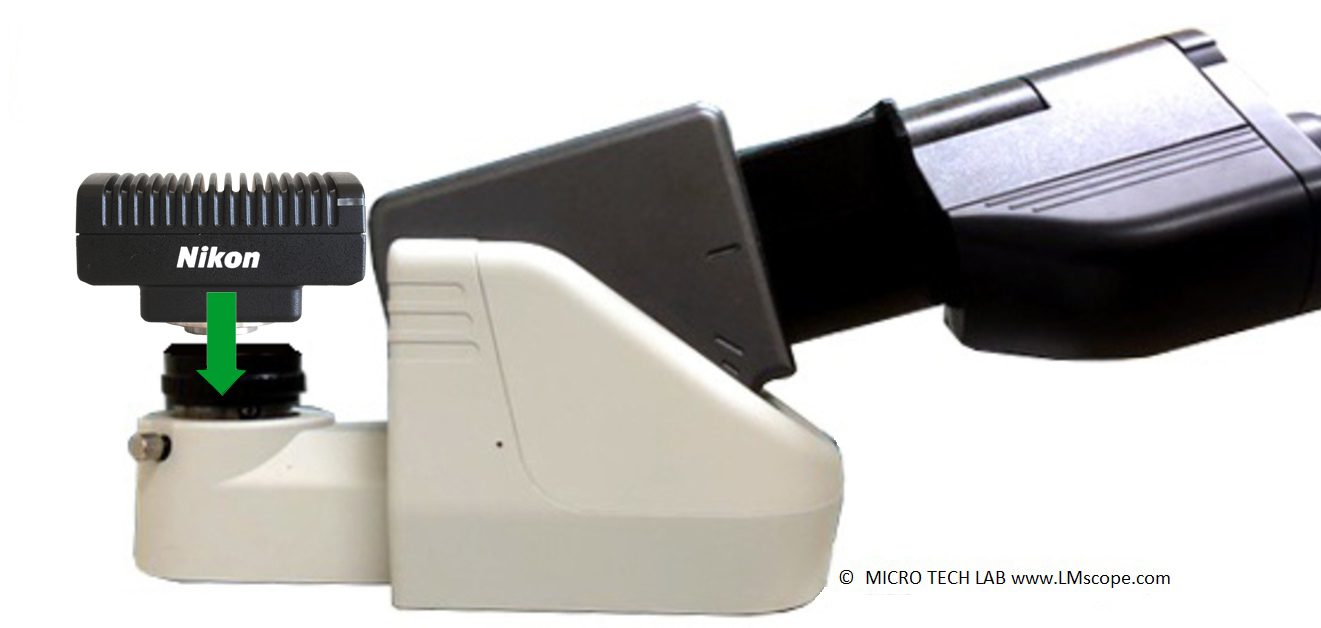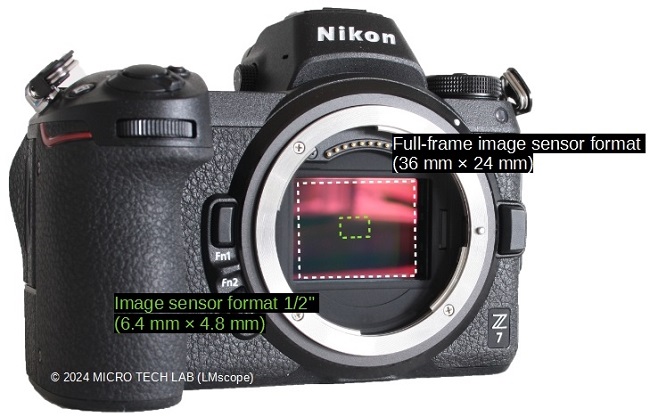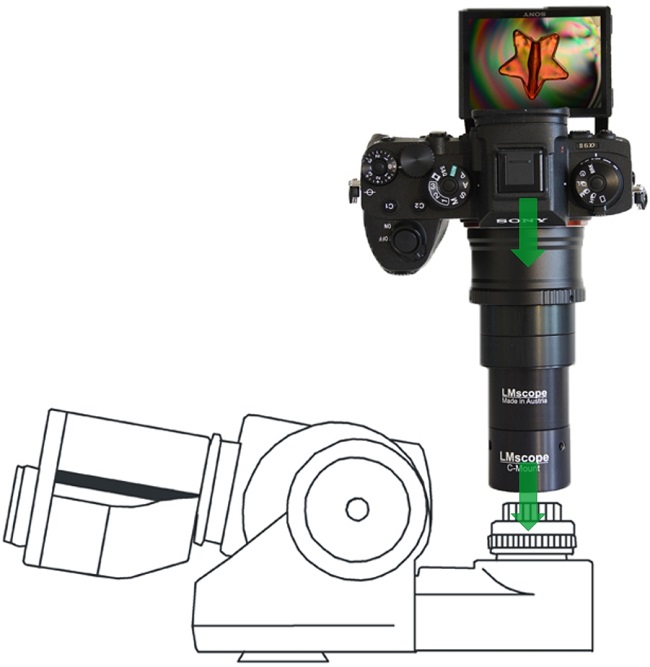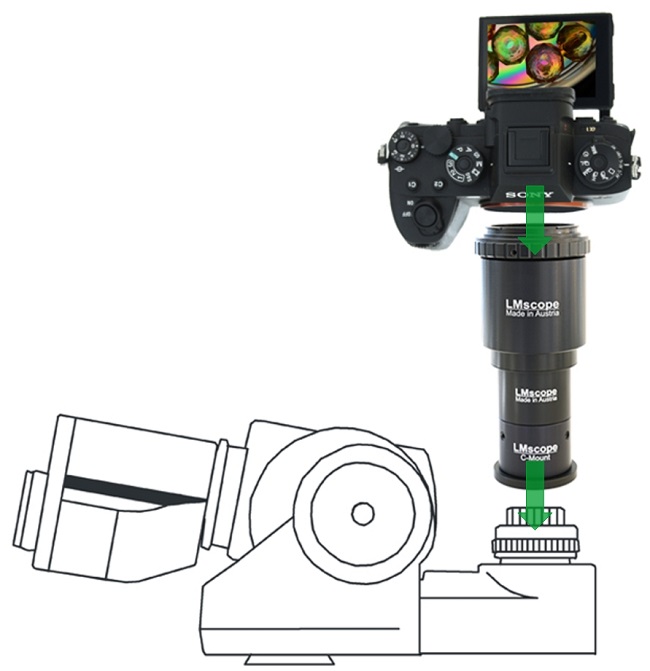

Using sophisticated cameras with Nikon microscopes equipped with a C-Tep2 ergo tube
Nikon’s Eclipse line of microscopes is synonymous with top-tier quality and performance. The fact that these microscopes are compatible with a wide range of large-sensor cameras makes them a compelling option for photomicroscopy applications.
A standout accessory within Nikon’s product range is the C-TE2 ergo trinocular head. It features a horizontal rear-facing output to which an angled C-mount port (C-TEP DSC port) is attached. The C-TEP DSC port has been designed specifically for C-mount cameras and includes a built-in lens with a reduction factor of 0.7x for optimising the field of view. This focal reduction is necessary to get a larger field of view with C-mount cameras featuring sensor sizes of about 2/3 inch.

Shown in the image: the C-TE2 trinocular head with the C_TEP DSC port and a Nikon C-mount camera
The 0.7x C-mount port’s short focal length typically prevents the use of large-sensor cameras. To bridge this gap, we have developed a specialised adapter solution so that high-quality digital cameras (DSLRs, DSLMs, etc.) can still be used with this photo port.
This adapter solution permits the unrestricted use of mirrorless system cameras, SLRs and even special-purpose microscope cameras with the C-Tep2 ergo tube. Large, high-quality image sensors generally have a greater dynamic range and excellent light sensitivity, which translates into significantly higher image quality compared to conventional C-mount microscope cameras.

For an optimal field of view aligned with the camera sensor, we have developed an adapter solution with integrated adjustment optics that is matched to the camera’s sensor size. The adapter has a built-in wide-angle lens which enables the camera to capture the largest possible field of view without any vignetting in the photo or video. As a rule, our adapters are focusable, allowing an optical alignment of the image observed through the eyepiece with that seen through the phototube.
Compact adapter solution for cameras with M4/3 and APS-C sensor:

Version for cameras with full-frame sensor:

Key features of LM microscope adapters
• Integrated precision optics for superior image quality
• Large lens diameter, high light gathering power for short shutter speeds
• High-quality mechanical build for a long service life
• Focusable adapter solution: image observed through the eyepiece can be aligned with that of the phototube
• Modular system can be individually configured
• Widefield optics or optics with infinitely variable magnification options
• Adapter solution allows integration of optical filters
• Flexible accessory modules
• Customer-specific adapter solution
• Professional customer support
• Developed and manufactured in Austria
For more information on making a camera selection, please refer to the page with our current camera recommendations. We are also happy to provide personalised advice, so please feel free to reach out at any time.
28.2.2024Photography:
Fitting the microscope to digital single-lens reflex (DSLR), mirrorless interchangeable-lens cameras (MILC ), digital single-lens mirrorless (DSLM) or C-mount cameras is easy with our LM digital SLR adapters, which feature a plan achromatic optical system. Our products make it possible to capture top-quality microscope images. To help you select the adapter that is right for your camera, we have set up an online configurator on our website. You can also email us – ideally with attached photographs of your microscope.
Modern DSLR and single-lens mirrorless (DSLM) offer the latest technology and are generally very well suited for microscopy applications. Most of them can be controlled remotely via PC/Mac. Because of their high sales volumes, they offer an excellent price/performance ratio compared to special-purpose microscope cameras.
Features of top DSLR and single-lens mirrorless cameras (DSLM):
- Large, powerful full-frame sensors (36 x 24 mm)
- Sensor resolution of 61 megapixels or 240 megapixels with Pixel Shift technology
- High light sensitivity (ISO 400,000+)
- Extensive dynamic range (up to 15 aperture stops/f-stops)
- Short exposure times (1/8000 second) up to 1/32,000 seconds using the digital shutter
- 4K Ultra HD or 8K Ultra HD video function
- Live video capture on external monitors in ultra HD quality
In most cases, these cameras are significantly more powerful than microscope cameras with smaller sensors (1/2" or 2/3"). On our website you will find our current camera recommendations and a camera ranking which is specifically tailored to microscopy applications.